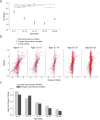Social influence on risk perception during adolescence
- PMID: 25810453
- PMCID: PMC4426139
- DOI: 10.1177/0956797615569578
Social influence on risk perception during adolescence
Abstract
Adolescence is a period of life in which peer relationships become increasingly important. Adolescents have a greater likelihood of taking risks when they are with peers rather than alone. In this study, we investigated the development of social influence on risk perception from late childhood through adulthood. Five hundred and sixty-three participants rated the riskiness of everyday situations and were then informed about the ratings of a social-influence group (teenagers or adults) before rating each situation again. All age groups showed a significant social-influence effect, changing their risk ratings in the direction of the provided ratings; this social-influence effect decreased with age. Most age groups adjusted their ratings more to conform to the ratings of the adult social-influence group than to the ratings of the teenager social-influence group. Only young adolescents were more strongly influenced by the teenager social-influence group than they were by the adult social-influence group, which suggests that to early adolescents, the opinions of other teenagers about risk matter more than the opinions of adults.
Keywords: adolescence; conformity; development; peer influence; risk perception; social influence.
© The Author(s) 2015.
Conflict of interest statement
Figures


References
-
- Berndt T. J. (1979). Developmental changes in conformity to peers and parents. Developmental Psychology, 15, 608–616. doi:10.1037/0012-1649.15.6.608 - DOI
-
- Brown B. B. (1990). Peer groups and peer cultures. In Feldman S. S., Elliott G. R. (Eds.), At the threshold: The developing adolescent (pp. 171–196). Cambridge, MA: Harvard University Press.
Publication types
MeSH terms
LinkOut - more resources
Full Text Sources
Other Literature Sources
Medical
Molecular Biology Databases

